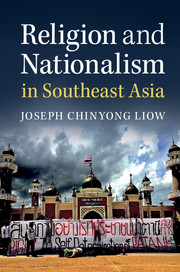Book contents
- Frontmatter
- Dedication
- Contents
- Preface
- Acknowledgments
- Glossary
- Introduction
- 1 Faith and Flag
- 2 Southern Philippines: Reframing Moro Nationalism from (Bangsa) Moro to Bangsamoro
- 3 Thailand's Southern Border Provinces: Constructing Narratives and Imagining Patani Darussalam
- 4 Malaysia: Religion, Ethno-Nationalism, and Turf-Guarding
- 5 Indonesia: Contesting Principles of Nationhood
- Conclusion
- Bibliography
- Index
Preface
Published online by Cambridge University Press: 05 August 2016
- Frontmatter
- Dedication
- Contents
- Preface
- Acknowledgments
- Glossary
- Introduction
- 1 Faith and Flag
- 2 Southern Philippines: Reframing Moro Nationalism from (Bangsa) Moro to Bangsamoro
- 3 Thailand's Southern Border Provinces: Constructing Narratives and Imagining Patani Darussalam
- 4 Malaysia: Religion, Ethno-Nationalism, and Turf-Guarding
- 5 Indonesia: Contesting Principles of Nationhood
- Conclusion
- Bibliography
- Index
Summary
Religion has always been an important theme in Southeast Asian history and culture. It has also been a crucial feature of the region's politics and specifically, as I hope to demonstrate in this book, in the conception of nationhood and the political contestations that have defined the history of the nation in Southeast Asia. Indeed, since the emergence of anti-colonial movements in the region, religion has animated and colored nationalism in Southeast Asia. Romantic nationalists from Myanmar (Burma) to Indonesia and the Philippines, in possession of great capacities for invention and myth-making, frequently capitalized on the “immutable” religious identity of “their people” in order to construct narratives that frame conceptions of nationhood beyond the imperative of material self-interest.
Such is the currency of these narratives, it harkens to Hugh Trevor-Roper's observation, made in his illuminating tome, The Invention of Scotland, that “for what people believe is true is a force, even if it is not true.” This conceptualization of nationhood using religious metaphors, vocabularies, and referents, I should add, was not merely confined to those anti-colonial movements that agitated successfully to liberate their nations from Western imperialism. Religion has been an equally robust, if at times overlooked, phenomenon on at least two further counts: first, as a feature in the process of post-independence nation and state building and consolidation and, second, in the articulation of resistance by groups within the territorial state but who do not share in its conception of nationhood. It is in the hope of untangling this dynamic thematic combination of religious identity, nationalism, and political contestation that Religion and Nationalism in Southeast Asia has been written.
The topic of religion and conflict has fascinated many a scholar of the region. The result has been the production of several excellent studies that explore the role of religion in political conflict from a wide array of perspectives ranging from economic inequality to minority identity, political legitimacy, and integration. Of particular note are Thomas McKenna's illuminating study of local politics in Cotabato, Edward Aspinall's study of how religious identity blended with nationalism in Aceh, Duncan McCargo's work on southern Thailand that focuses on the legitimacy-deficit of the Thai state in the Malay south, and John Sidel's masterly analysis of the kaleidoscopic violence perpetrated by religiously inspired groups in Indonesia. This book hopes to add to this literature in at least two ways.
- Type
- Chapter
- Information
- Religion and Nationalism in Southeast Asia , pp. ix - xiPublisher: Cambridge University PressPrint publication year: 2016

